Overcoming Top 10 eCommerce Challenges in 2024
As consumer behavior changes and technology progresses, the eCommerce sector is undergoing a transformation that offers boundless opportunities. However, it is also posing a slew of new and unique challenges due to various factors (Figure 1). It is important for the industry to be aware of those challenges and to steel their strategies.
This article explores the top 10 eCommerce challenges and presents strategic solutions to help businesses flourish. By exploring the challenges and providing exemplified solutions, this article aims to provide a blueprint for eCommerce success.
Figure 1. Factors challenging the eCommerce industry in 2022
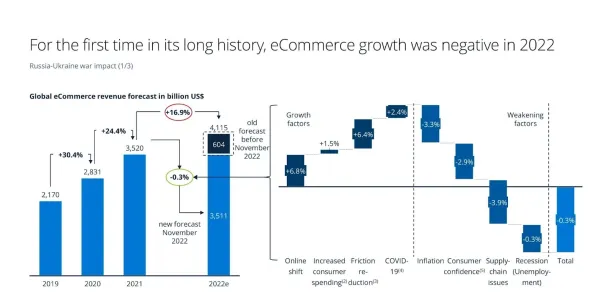
Challenge 1: Leveraging eCommerce data
eCommerce businesses can do wonders with market and competitor data. However, gathering and using such data has become challenging due to the following reasons:
- Size and complexity of data: The internet offers a large amount of data from e-commerce platforms. Collecting data from various web sources may be challenging since each data source may contain different data types, like structured, semi-structured or unstructured. For instance, if you intend to gather data on a large scale, you may encounter challenges such as rate limits or JavaScript challenges imposed by e-commerce websites.
- Dynamic nature: Most e-commerce websites like Amazon use JavaScript to load and display content based on visitors’ preferences and activities. The constantly changing nature of prices, promotions, and products in e-commerce complicates data accuracy and requires continuous monitoring.
- Data quality and accuracy: The reliability and accuracy of data sources vary, leading to potential inaccuracies and poor business decisions.
- Variety of data types: The diverse types and formats of data from different e-commerce sites necessitate a variety of analysis skills and additional manpower.
- Legal and ethical considerations: Compliance with varying data privacy regulations and ethical standards adds complexity to data gathering, storage, and use.
- Competitive intelligence: Collecting data on competitors’ strategies is difficult due to limited disclosure and rapid changes.
- Analysis and interpretation: Businesses face challenges in analyzing and interpreting the gathered data to extract actionable insights, requiring advanced analytics capabilities.
Solution: Invest in digital analytics tools
Investing in an eCommerce analytics tool can help businesses gain insights from their data. A prime example is Netflix1, which uses data analytics to personalize recommendations and improve user experience.
Sponsored
Bright Data offers an automated web data platform called Bright Insights to help eCommerce businesses gather and leverage relevant eCommerce data. The platform:
- Offers real-time data collection and analytics of multiple competitors
- Tracks competitor pricing for their products and services
- Monitors competitor product catalogs to help you improve yours
- Monitors the consumer sentiment toward your brand

Challenge 2: Building digital trust
Online businesses operate in an environment where customers cannot physically see or touch the products. Consequently, building trust can be a hurdle. Cybersecurity threats also undermine trust in eCommerce platforms.
Solution: Improve security and transparency
Trust can be built in two ways:
Improve security
Businesses should adopt SSL certificates, two-factor authentication, and other cybersecurity measures to reassure customers. Having certifications like ISO 27001 and GDPR compliance can reassure the customer that the company will not abuse their data.
Improve transparency
Transparency about business practices and products can also build trust. More transparency can lead to reduced returns which cost around $400B1 to the US retail market. Make sure to implement effective product data management with accurate product images and information so that the customers know what they are buying.
Challenge 3: Ensuring customer loyalty
The level of loyalty among customers is falling (Figure 2). This means they will not hesitate to take their business elsewhere if they do not like something about the retailer. This trend has made retaining customers in the eCommerce sector a significant challenge. Businesses must not only attract customers but also keep them coming back.
Solution: Personalize the user experiences
Personalized marketing, superior customer service, and a seamless user interface can enhance customer loyalty. You can ethically and legally use customer data with analytical tools to tailor the shopping experience for the shoppers.
Check out our wide range of research on improving your customers’ experience.
Figure 2. State of customer loyalty in 2022
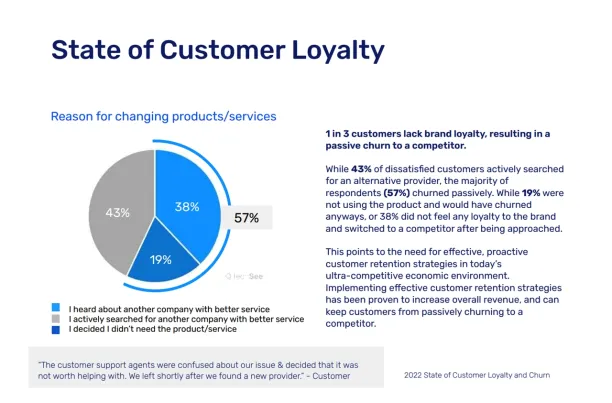
Challenge 4: Streamlining eCommerce logistics
Supply chain and logistics-related services are among the top important factors for online shoppers (Figure 3). Effective logistics and supply chain management are crucial for timely delivery and customer satisfaction, but coordinating these elements can be challenging.
Solution: Investing in technology
Incorporating AI and data analytics can streamline supply chain processes. Walmart’s2 use of blockchain technology for supply chain transparency exemplifies this solution.
Figure 3. Delivery-related factors are important for U.S. online shoppers in 2021
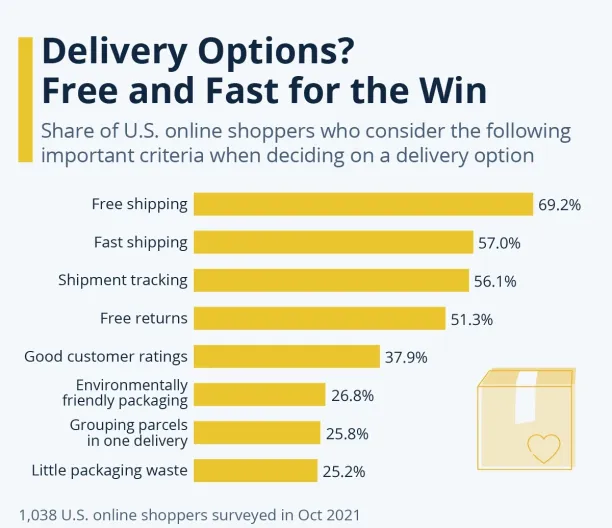
Challenge 5: Managing cross-border eCommerce
Cross-border eCommerce brings complexities like handling different tax laws, shipping regulations, and cultural preferences. This can be especially challenging for retailers with an international supplier network and customer base.
Solution: Comprehensive research and partnerships
Thorough research and strategic partnerships can help businesses navigate these challenges. eBay2, for instance, has a Global Shipping Program to manage international logistics.
Challenge 6: Creating an effective eCommerce website
An easy-to-navigate and visually appealing website for your eCommerce store is crucial, but achieving this balance is challenging. For online retailers that offer a wide range of products and services, achieving such a website can be challenging.
Solution: Focus on user experience
Prioritizing user experience in website design can enhance customer satisfaction. Make sure to:
- Choose a clean design
- Ethically and legally leverage user data
- Monitor user navigation on the website
Businesses can also leverage a website change monitoring tool to stay informed about their updates, track price changes on e-commerce websites, and promptly address any website problems.
Challenge 7: Harnessing the potential of mobile commerce
Mobile commerce is booming (Figure 4), but optimizing eCommerce platforms for mobile is a complex process due to the following reasons:
- Mobile device variety: eCommerce platforms need to be compatible with a wide array of mobile devices, each with varying screen sizes, resolutions, and operating systems.
- Page load speed: Mobile users expect fast page loading times, necessitating file size reduction, code minimization, and caching to optimize performance.
- Security: The popularity of mobile commerce attracts cybercriminals, necessitating robust security measures to protect customer data and transactions.
- Integration with mobile features: The technical challenge of integrating mobile features, such as GPS, camera, and accelerometers, can enhance the shopping experience.
- Adapting to rapid changes: Constant changes in the mobile landscape require eCommerce platforms to continually adapt through ongoing optimization and testing.
Solution: Mobile-friendly design
Investing in responsive website design can cater to mobile users. You can also work with an experienced mobile app developer to make the process more efficient.
Figure 4. Mobile commerce market U.S.A.
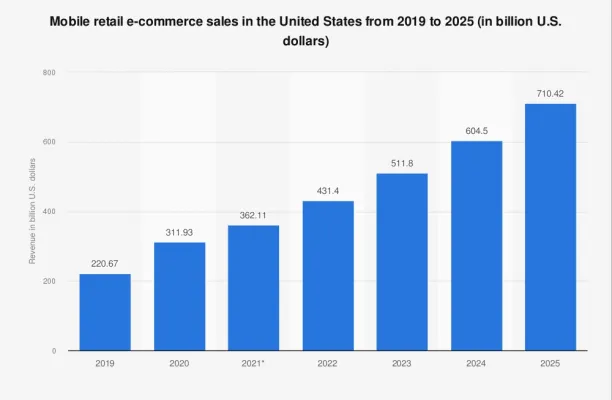
Challenge 8: Handling returns and refunds
Managing product returns and refunds can be an administrative headache and a financial burden for online retailers. This is mainly because it involves time-consuming processes like re-stocking, quality checking, and refunding while also impacting profitability through lost sales and additional shipping and handling costs.
Solution: Clear policies and efficient systems
You can consider the following remedies:
- Having clear return and refund policies.
- Leveraging an automated return system
- Leveraging return data to improve the process
The American shoe and clothing retailer, Zappos3, is popular for having a hassle-free return policy and efficient processing.
Challenge 9: Ensuring high-quality content
Compelling product images and accurate descriptions are crucial for sales but can be challenging to execute consistently. This is significantly challenging for retailers with large product lines.
Solution: Professional product presentation
You can consider the following solutions:
- Investing in professional photography and copywriting can enhance product appeal.
- Using accurate product tagging and data categorization
Challenge 10: Delivering good online customer service
Providing prompt and effective customer service in an online setting can be a challenge due to the lack of face-to-face interaction.
Solution: Omnichannel customer service
Using multiple channels in your online business, like email, chatbots, and social media, for customer service can improve responsiveness.
Check out this quick read to learn more about how conversational AI can help improve customer service.
Further reading
- 12 Best Practices of Ecommerce Market Intelligence
- Top 18 Ecommerce KPIs to Measure Business Success
- Top 10 E-commerce Analytics Tools & Selection Guide
If you need help finding a vendor or have any questions, feel free to contact us:
References
- National Retail Federation (Jan 11, 2021). ‘Customer Returns in the Retail Industry’. NRF. Accessed: 30/May/2023
- Vitasek et al. (Jan 05, 2022). “How Walmart Canada Uses Blockchain to Solve Supply-Chain Challenges”. Harvard Business Review. Accessed: 31/May/2023


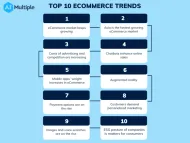
Comments
Your email address will not be published. All fields are required.